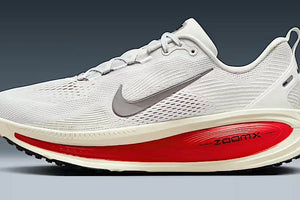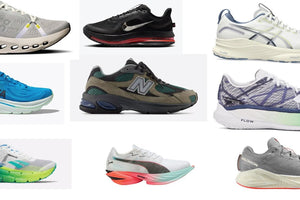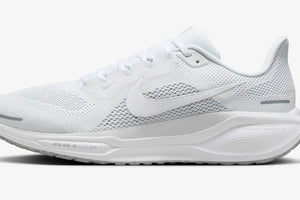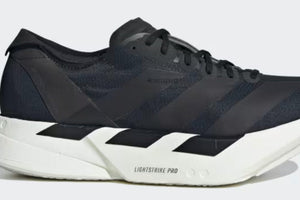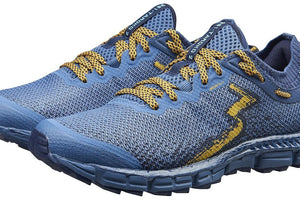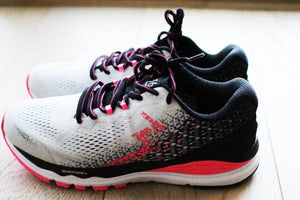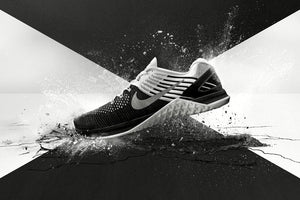Right then, let's have a proper look at the new Nike Pegasus Premium, shall we? It's fair to say this isn't your typical workhorse Pegasus; Nike's pitched this one as a "super trainer", loaded with all sorts of fancy cushioning bits. We're talking a triple-decker midsole with ZoomX foam, a full-length Air Zoom unit, and ReactX foam all crammed in there. The idea? A cracking blend of bounce and cushioning. But what do the folks who've actually laced 'em up reckon? And what about the experts who know their trainers inside out? Let's dive into the nitty-gritty.
The Good Bits of the Nike Pegasus Premium
A Ride That Puts a Spring in Your Step: Time and again, runners are raving about how darn enjoyable the Pegasus Premium feels underfoot. Words like "fun" and "engaging" pop up all over the place, with a real sense of oomph coming back with every stride. That full-length Zoom Air unit working its magic with the ZoomX foam seems to be the key. One of the clever clogs who reviews trainers reckoned it was a "surprisingly springy and enjoyable ride," really highlighting that energy return. Nike themselves claim it's the bounciest Pegasus ever, and it sounds like they might be onto something, with one runner describing the cushioning as "supercharges responsive" and the energy return as "unlike any other" Pegasus. Underfoot, it's often called "springy" and "premium," making your runs feel a bit more lively. Regular runners agree, with one saying the air unit was "incredibly bouncy and cushioned," even better than they expected. The midsole combo is likened to "bouncy fun" and even "lacing up little trampolines for your feet" - you can't get much more enthusiastic than that! Testers keep mentioning that "springiness underfoot" and the overall "bouncy" feel, which definitely adds to the excitement of a run. That "incredibly bouncy and cushioned" feeling from the air unit is a real winner for many. Bottom line? The midsole often gets described as giving an "effortless" ride with an "undeniable bounce," making the Pegasus Premium a trainer that plenty of people genuinely enjoy clocking up the miles in.
Comfy and Lets Your Feet Breathe: The way the upper's put together, using engineered mesh and a circular knit, generally gets a thumbs-up for being comfy and letting your feet breathe nicely. Reviewers often point out the "excellent breathability," suggesting your feet won't get too sweaty on a run. Nike aimed for a "lighter-than-air upper," which is supposed to help with breathability and keep the overall weight down (though we'll get to that later!). The upper's often described as striking a good balance between being "breathable yet secure," so you get ventilation without feeling like your foot's going to slip about. Everyday runners back this up, saying the upper "fits great and is very breathable," making for a comfortable run. Loads of testers have found it to be "breathable and very comfortable," giving a secure fit without feeling tight. The mix of engineered knit and circular knit is specifically praised for how it feels.
Grippy on the Tarmac: The tweaked waffle outsole on the Pegasus Premium generally gets the nod for providing reliable grip on roads. Experts reckon it's got "great traction," putting it down to the softer rubber and a more aggressive lug pattern compared to the Pegasus 41. This design is meant to give you better grip, so you feel more confident on your runs. Testers have said they've had "no issues with grip on the roads," which suggests the outsole does what it's supposed to on typical running surfaces. Overall, the "grip of the Pegasus Premium is really good," further proving its worth on paved roads. The "waffle traction outsole" is specifically designed to give superior grip, making it a dependable choice for road running.
You'll Be Seen in the Dark: A cracking safety feature on the Pegasus Premium is its seriously reflective upper, designed to make you more visible when it's a bit gloomy. Reviewers often describe the upper as "highly reflective," with some mentioning a full 360-degree reflectivity thanks to a thick strip that goes all the way around the shoe. The fact that there are "reflective elements all around the upper" also helps with visibility in low light. A "band of reflective material" is also highlighted as a key feature for nighttime runs. One expert even said the reflectivity was "the best of any shoe" they'd tested, which really emphasizes how effective the design is.
Looks the Business: The way the Nike Pegasus Premium looks often gets a mention, with many reviewers and runners finding it stylish and even smart enough to wear when you're not running. Some reviewers have said it "looks more like a lifestyle shoe than a running sneaker," suggesting it's got a design that goes beyond just performance. The initial impression for some was that it could be seen as a "fashion shoe first, running shoe second" because of its distinctive appearance. Everyday runners often just say it "looks really nice." The design has been described as having "great aesthetics," with some people even comparing it to popular Nike Air Max trainers. The general feeling is that Nike has created a visually appealing shoe that a lot of people find attractive.
The Not-So-Good Bits and Drawbacks of the Nike Pegasus Premium
A Bit on the Heavy Side: A major and consistently reported downside of the Nike Pegasus Premium is that it weighs quite a bit. This weight is often seen as taking away from the feel you'd expect from a super trainer, pushing it more towards being a lifestyle trainer. The significant weight is frequently mentioned as a problem for faster runs and can become particularly noticeable when you're going for longer distances. One expert reviewer pointed out that the weight "deviates from the expected feel of a super trainer" and thinks it's "too heavy for uptempo runs." Another review mentions that at nearly 10 ounces (around 283 grams in a UK size 8), it's on the heavier side compared to many modern running shoes. The Pegasus Premium is also described as "much heavier" than the standard Pegasus 41. Some reviewers suggest that the weight (around 330g for a UK size 10) might put some runners off. It's also considered "heavy for a daily trainer." Regular runners agree, with some saying it feels like one of the heaviest shoes they've reviewed. The shoe is even described as being "among the heaviest shoes on the market." The weight is explicitly stated as a major concern, with one reviewer even exclaiming, "This shoe is heavy AF!". This substantial weight is felt to make the shoe less versatile and potentially less appealing to runners who prioritize speed and efficiency.
Pricey, Isn't It? The cost of the Nike Pegasus Premium, usually around £185, is frequently mentioned as a significant drawback. Many reviewers question whether the premium features justify this high price, especially when you consider the weight and how versatile it might be. Some experts reckon it's a "questionable investment" for serious runners given how much it costs. While some acknowledge that £185 is an investment, they also point out that there might be more affordable alternatives out there that offer similar or even better performance. Everyday runners often say the price is "very steep" and might not be worth it for what you get. The value for money is questioned, with some wondering if the shoe is really worth such a significant outlay. The high price is often compared to other top-end, highly cushioned shoes, suggesting that the Pegasus Premium sits at the pricier end of the spectrum.
Could Be a Bit More Stable: The way the Pegasus Premium is designed, with a narrower midfoot and rearfoot along with a high stack height, raises concerns about how stable it might be, especially for runners who land on their heel or midfoot, and during longer runs. Experts note that the narrowness in the middle and back of the shoe could cause stability issues, particularly as you get more tired on longer runs. The high stack height, while giving you lots of cushioning, can also make it less stable for some runners. When compared to the Pegasus 41, the latter is often seen as more stable because it has a thinner midsole. The narrow midfoot is specifically mentioned as something that can make it less stable. While Nike has tried to address stability problems that can happen with full-length Air Zoom units, some reviewers still notice a bit of instability in the heel. The shoe is generally classified as neutral, and its narrow sole, especially in the midfoot, adds to this lack of inherent stability. The Air Zoom unit itself can feel a bit like running on a balance ball, which could make any instability feel more pronounced.
A Snug Fit: A common observation is that the Nike Pegasus Premium tends to have a narrow fit, particularly in the midfoot and toe-box, which might not be great for runners with wider feet. This is a pretty standard thing with Nike running shoes, and the Pegasus Premium seems to follow suit. Some reviewers explicitly say that the narrow midfoot and toe-box make it unsuitable for runners with wider feet. While runners with narrower feet might find the fit secure and comfortable, those with wider feet might find it uncomfortable. The toe box is sometimes described as being tapered, which can feel a bit short or put pressure on the big toe for some people. Even going up half a size might not solve the narrowness for some runners.
Not the Most Versatile: The combination of the Pegasus Premium's weight and potential instability can limit how versatile it is for different types of runs. It's often thought to be too heavy for fast-paced workouts like tempo runs or track sessions. Also, the potential instability can make it less ideal for very long distances for some runners. While it works well for easy and recovery miles for many, its limitations for both faster and longer paces mean it might not be the best all-around trainer. Some reviewers suggest that there are more efficient and lighter options available if you want to run faster.
Might Get a Bit Warm: The well-padded upper, especially around the collar and tongue, while making it feel comfy when you first put it on, might mean your feet get a bit warm when the weather's warmer. All that material on the upper could potentially make the shoes feel hot during summer runs. The padded tongue, while comfortable, is specifically mentioned as something that could make your feet feel hotter in warm weather.
A Tad Noisy: One specific drawback mentioned in a couple of reviews is that the Pegasus Premium can be quite noisy when you're just walking around. This is seen as a minor annoyance that doesn't affect how it performs when you're running but might be something to think about if you were planning on wearing the shoe casually as well.
Clunky Heel Feel: Some reviewers have noticed a clunky feel in the heel when they land, which they reckon is down to the sole design not having a very significant bevel (that angled bit at the back). This can make the 10mm heel-to-toe drop feel more noticeable and might affect how smoothly you transition from heel to toe for some runners.
Nike Pegasus Premium: The Techy Bits
Midsole Magic: The midsole of the Nike Pegasus Premium is a clever bit of engineering, using three different types of cushioning stacked on top of each other. The top layer is ZoomX foam, which is Nike's bounciest foam and known for giving back a lot of energy. Sandwiched underneath the ZoomX is a full-length Air Zoom unit, designed to give a springy and responsive feel right through your foot. Finally, the bottom layer in the heel is made of ReactX foam, which offers stability and a smooth ride, and Nike claims it's 13% bouncier than their previous React tech. Interestingly, there's no traditional plate or shank in the midsole; however, the full-length Air Zoom unit is said to act a bit like a stiffener, especially in the front of the shoe. The Air Zoom unit is also shaped to follow the natural curves of your foot, aiming to make the transition from heel to toe smoother.
Outsole Grip: The outsole of the Pegasus Premium uses a modified waffle pattern made with a tough rubber to give good grip on roads. It's got the classic Pegasus waffle lugs that go all the way along the shoe. The rubber used is reportedly softer than on the Pegasus 41, which helps with grip. The lugs are also noted as being smaller and more aggressive compared to the Pegasus 41. While the grip is generally praised, the overall durability of the outsole is considered about average for a trainer. The outsole design covers almost the entire bottom of the shoe, which is meant to make it more durable.
Upper Comfort and Safety: The upper of the Pegasus Premium is made from a mix of engineered mesh and circular knit materials, chosen because they're breathable and can give a secure fit. For better safety, the upper has highly reflective bits to make you more visible in low light. Comfort is taken care of with a good amount of padding around the collar and heel tab. The tongue is soft and often has little holes in it to help with breathability. While the length of the shoe generally fits true to size, it's consistently reported as being narrow, especially in the midfoot and toe-box. Some users have also mentioned that the laces can be a bit on the short side.
Weighty Matters: The weight of the Nike Pegasus Premium can vary slightly depending on where you look and what size you're talking about. For a men's UK size 9, it's around 312 grams. For a UK size 10, it's about 330 grams. For women's sizes, a UK size 6 is around 263 grams, and a UK size 7.5 is about 275 grams. These figures consistently put the Pegasus Premium on the heavier side when you compare it to many other running shoes in the same category.
Heel-to-Toe Drop: The heel-to-toe drop of the Nike Pegasus Premium is consistently reported as being 10mm across various sources.
Stacking It High: The stack height of the Pegasus Premium measures a hefty 45mm in the heel and 35mm in the forefoot. This high stack definitely puts the shoe in the maximalist cushioning category.
Digging Deeper into the Key Ideas
Midsole Tech Working Together? The Nike Pegasus Premium's midsole is designed to use the unique qualities of three different cushioning technologies: ZoomX foam, the full-length Air Zoom unit, and ReactX foam. ZoomX foam, right under your foot, is meant to be super responsive and give back a lot of energy, something you often see in Nike's top racing shoes. The full-length Air Zoom unit, below the ZoomX, aims to boost this responsiveness with its natural springiness, giving a cushioned yet propulsive feel all through your foot. Lastly, the ReactX foam in the heel is there to provide a stable landing and help give a smooth, balanced ride, while also being more responsive than previous React foams. While many reviews acknowledge the enjoyable and bouncy ride, there are a few things to consider. The reported heavy weight of the shoe is often felt to counteract how responsive it could be, especially when you're trying to run faster. The balance between the plush cushioning and that desired "pop" is a bit of a talking point, with some finding it effective while others feel the weight reduces the energy return. The stability from the ReactX in the heel is also something people discuss, as the narrow midfoot design can still make some runners feel a bit unstable.
Cushioning vs. Responsiveness: The Nike Pegasus Premium tries to find that sweet spot between giving you loads of cushioning, like a maximalist shoe, and offering a responsive ride that works for different types of runs. Many reviewers do say it's very cushioned, making it comfy for everyday miles and longer runs for some. The ZoomX foam and the full-length Air Zoom unit definitely add a noticeable bounce and springiness, which is often seen as responsiveness. However, a recurring issue is whether the shoe really keeps that responsiveness, especially at faster speeds, given how heavy it is. Some reviewers feel that the weight cancels out some of the potential energy return from those highly responsive foams. While some testers find a "happy medium between soft and firm" with a bouncy feel underfoot, others suggest that the weight becomes more obvious the faster you go, hindering the overall responsiveness. How responsive it feels seems to be a bit of a personal thing, with some runners finding it "impressively responsive" despite its weight, while others think lighter shoes are better for faster paces. The lively and fun feel from the bounce is a definite plus for the cushioning, but whether that translates into efficient responsiveness for speed work is still up for debate.
Is It Worth the Money? Working out whether the Nike Pegasus Premium is good value for money means looking at its high price, its weight, how it performs, and how versatile it is compared to other running shoes out there. While the shoe uses premium cushioning tech and offers a unique and enjoyable ride for many, that £185 price tag makes you wonder if these features really justify the cost. Some reviewers think it's a "questionable investment," especially for serious runners who might find more versatile or better-performing options for a similar or even lower price. While some argue that it's a more affordable and versatile alternative to Nike's dedicated racing shoes, others point out that its weight and potential instability limit how versatile it is compared to other daily trainers or even some super trainers on the market. Whether it's good value seems to depend on what you personally prioritize. Runners who really value a bouncy and cushioned ride and aren't too bothered about weight or budget might find it worthwhile. However, for those who prioritize lightweight performance, maximum versatility, or a more budget-friendly option, the Nike Pegasus Premium might not be the best value.
How It Stacks Up Against Other Trainers
Nike Pegasus Premium vs. Nike Pegasus 41:
| Feature | Nike Pegasus Premium | Nike Pegasus 41 |
|---|---|---|
| Weight (M UK 9) | ~312g | ~283g |
| Stack Height (Heel/Fore) | 45mm/35mm | 37mm/27mm |
| Heel-to-Toe Drop | 10mm | 10mm |
| Midsole | ZoomX, Full-length Air Zoom, ReactX | Full ReactX, 2 Hidden Zoom Air Units |
| Price (GBP) | £185 | £120 |
The Nike Pegasus Premium and the Nike Pegasus 41, despite sharing the Pegasus name, are quite different beasts in the running shoe world. The Pegasus Premium is positioned as the top-of-the-line "super trainer," boasting Nike's most advanced cushioning tech and a significantly higher price tag. In contrast, the Pegasus 41 is the classic mid-range, neutral daily trainer known for being reliable and versatile
A key difference lies in the midsole gubbins: the Premium's got that triple-layered affair with ZoomX, a full-length Air Zoom unit, and ReactX, while the 41 makes do with a full ReactX midsole and a couple of smaller, hidden Zoom Air units. This difference in tech means the Premium gives a much bouncier and more engaging ride compared to the 41's firmer, more workhorse-like feel. The Premium's also got a considerably higher stack height, putting it firmly in maximalist territory. However, all that extra cushioning adds weight, with the Premium being noticeably heavier than the 41. While the Premium aims for a bit of a special, unique ride, the 41 is all about consistent comfort for your everyday jogs.
When it comes to stability, the Pegasus 41 generally comes out on top, thanks to its lower stack height and thinner midsole. The uppers are different too; the Premium uses a thin, breathable circular knit mesh with loads of reflective bits, while the 41 has a more traditional engineered mesh with a roomier fit and comes in wider sizes.
Ultimately, choosing between the two boils down to what you're after. If you want a fun, bouncy ride with maximum cushioning and aren't too fussed about weight, the Premium might be your bag. But if you're after a lighter, more versatile, and budget-friendly daily trainer, the Pegasus 41 is probably the better bet.
Nike Pegasus Premium vs. Other "Super Trainers":
| Feature | Nike Pegasus Premium | NB FuelCell SC Trainer v3 | Puma Deviate Nitro 2 | Hoka Mach X | Mizuno Wave Rebellion Pro 2 | ASICS GEL-Nimbus 25 | Brooks Glycerin 20 |
|---|---|---|---|---|---|---|---|
| Weight (M UK 9 approx.) | ~312g | ~265g | ~263g | ~269g | ~225g | ~292g | ~286g |
| Stack Height (Heel/Fore) | 45mm/35mm | 40mm/34mm | N/A | 39mm/34mm | 41.5mm/37.5mm | 41.5mm/33.5mm | 38mm/28mm |
| Heel-to-Toe Drop | 10mm | 6mm | N/A | 5mm | 4mm | 8mm | 10mm |
| Price (GBP approx.) | £185 | £160 | £140 | £160 | £230 | £175 | £160 |
When you pit the Nike Pegasus Premium against other "super trainers", it's got a pretty unique profile. The New Balance FuelCell SC Trainer v3 is noticeably lighter, which is a big plus if you prefer a less clunky feel. The Puma Deviate Nitro 2 is also lighter and often praised for its versatility. The Hoka Mach X offers a similarly cushioned ride but with a lower drop and often a more agile feel. The Mizuno Wave Rebellion Pro 2 is significantly lighter and geared more towards faster paces with a very distinct, propulsive feel. The ASICS GEL-Nimbus 25 offers a very plush and cushioned ride, often prioritising comfort over outright speed, and is generally lighter. The Brooks Glycerin 20 is another highly cushioned option, often seen as a direct competitor in terms of plushness, though the ride feel can differ.
Overall, the Pegasus Premium stands out for its specific bouncy feel from that triple-decker midsole. However, its heavier weight and higher price point might make other super trainers more appealing depending on what you're looking for in a shoe. If you prioritise lightweight performance or a more versatile shoe for different types of runs, you might find better options elsewhere.
Final Thoughts and Recommendations
The Nike Pegasus Premium offers a distinctive running experience with its fun, bouncy, and highly cushioned ride, mainly thanks to that innovative triple-stack midsole. The comfy and breathable upper, good grip, and enhanced reflectivity are also big ticks in its box. However, its significant weight and relatively high price are major drawbacks that affect how versatile it is and whether it's good value for money. The narrow fit might also rule it out for some runners, and the potential for instability due to the high stack and narrow midfoot could be a concern for others.
Who might get on well with the Nike Pegasus Premium?
- Runners who really value a highly cushioned and enjoyable ride for easy to moderate-paced daily miles and are happy to accept the extra weight.
- Those with narrower feet who usually find Nike's fit comfortable will likely appreciate the secure feel of the upper.
Who might want to look elsewhere?
- Runners who prioritise lightweight performance or need significant stability for overpronation.
- Those seeking a highly versatile shoe for a wide range of paces and distances might find the Pegasus Premium a bit limiting.
- Budget-conscious runners should carefully weigh up the £185 price tag and decide if the unique ride justifies the cost compared to other well-regarded daily trainers or even some super trainers available for less.
In conclusion, the Nike Pegasus Premium is a bold move for the Pegasus line, bringing in premium tech to deliver a unique and exciting running experience. While it definitely succeeds in providing a highly cushioned and bouncy ride with a stylish look, the compromises in weight and price might mean it's a bit of a niche offering in the competitive running shoe market. It'll likely appeal most to runners who prioritise a specific type of underfoot feel over all-out performance and versatility.



